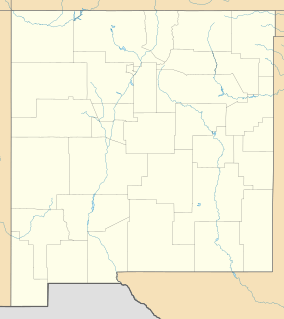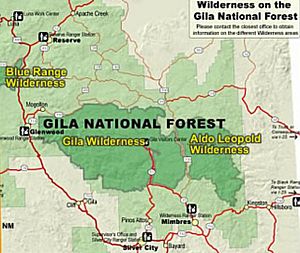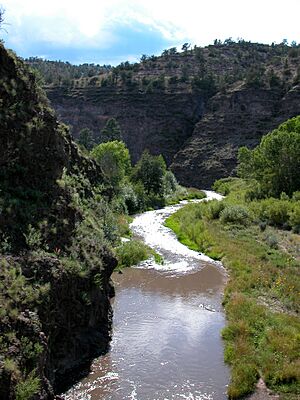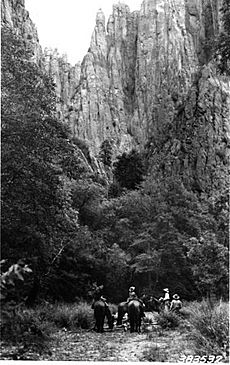Gila Wilderness facts for kids
Quick facts for kids Gila Wilderness |
|
|---|---|
|
IUCN Category Ib (Wilderness Area)
|
|
| Location | Catron/Grant counties, New Mexico, United States |
| Nearest city | Silver City, New Mexico |
| Area | 558,014 acres (225,820 ha) |
| Established | 1924 |
| Governing body | United States Forest Service |
The Gila Wilderness is a special place in New Mexico, United States. It was the world's very first "wilderness area," created on June 3, 1924. This means it's a large natural space where people can enjoy nature without roads or buildings.
The Gila Wilderness is huge, covering about 558,014 acres (225,820 ha). That's like 872 square miles! It's part of New Mexico's Gila National Forest. The area is about 27 miles (43 km) long from north to south and 39 miles (63 km) wide from east to west.
In U.S. Wilderness Areas, you won't find cars, motorcycles, or even bicycles. Instead, people explore on foot or horseback. You can go camping, hunting, and fishing here if you have the right permits. But there are no roads, buildings, or mining allowed.
The Gila Wilderness is in southwest New Mexico, near Silver City. It includes parts of the Gila River, where the land is lowest, around 4,850 feet (1,478 m) high. The Mogollon Mountains run through the wilderness. The tallest peak is Whitewater Baldy, which is 10,895 feet (3,321 m) tall! The Gila Cliff Dwellings National Monument is also very close by.
Contents
History of the Gila Wilderness
Who Lived in the Gila Wilderness First?
Long ago, between 1000 and 1130 AD, the Mimbres people lived in the Gila Wilderness area. They were a group of the Mogollon culture. They left behind amazing cliff dwellings and other signs of their ancient culture. Later, between 1200 and 1600, the Chiricahua band of Apache people moved into this area. They were very protective of their land, which helped keep it wild until the 1870s.
How the Gila Wilderness Was Created
In 1922, a man named Aldo Leopold had a great idea. He worked for the United States Forest Service. He suggested that the area where the Gila River begins should be protected. He wanted to keep it wild by not building roads or allowing certain activities. Because of his hard work, this area became the first wilderness area in the National Forest System in 1924.
Later, in 1964, the Wilderness Act was signed into law by President Lyndon B. Johnson. This law made the Gila Wilderness the first "congressionally designated wilderness." This means it was officially protected by the U.S. government.
Plants and Animals of the Gila Wilderness
What Kinds of Plants Grow Here?
The Gila Wilderness has many different kinds of plants. At high elevations, above 9,000 feet (2,732 m), you'll find spruce and fir trees, and quaking aspen. Between 6,500 feet (1,981 m) and 9,000 feet (2,732 m), there are forests of ponderosa pine. Lower down, and on dry, sunny slopes, you'll see pinyon and juniper trees, and desert plants.
The wilderness is a mix of plants from the Chihuahuan Desert and the Rocky Mountains. You can find mesquite and Apache pine trees here. The Chihuahua pine also grows here, and this is its northernmost home. The Gila has one of the biggest and healthiest ponderosa pine forests in the world. Along rivers and in canyons, you'll see Arizona sycamore, walnut, maple, ash, cottonwood, alder, and willow trees.
Amazing Animals of the Gila Wilderness
The Gila Wilderness is home to many cool animals. You might spot predators like bobcats and cougars. There are also Mule deer, white-tailed deer, and pronghorn. Other mammals include the black bear, collared peccary, gray fox, and white-nosed coati.
A very special animal here is the Mexican wolf. These wolves are critically endangered, meaning they are at high risk of disappearing forever. In 1988, some captive-raised Mexican wolves were released into the wilderness to help their population grow.
Bighorn sheep used to live here but disappeared around 1900. They were brought back to the Gila Wilderness after 1958. Elk were also reintroduced in 1954 from Yellowstone National Park.
Birds and Reptiles
You can see many birds in the Gila Wilderness. Game birds like wild turkey and dusky grouse live here. Birds of prey include the common black hawk, zone-tailed hawk, goshawk, osprey, and bald eagle. American dippers can be found in mountain streams. The wilderness also has the largest group of spotted owls, which are a near threatened species.
For reptiles, you might rarely see an Arizona coral snake or a Gila monster. More common snakes include the black-tailed rattlesnake and Sonora mountain kingsnake.
Fish in the Rivers and Streams
The rivers and streams are full of fish like Brown trout, rainbow trout, catfish, and bass. The Gila trout is a threatened fish found in Iron, McKenna, and Spruce Creeks. It likes deep water, especially in beaver ponds, which protect it from floods and droughts.
Template:Gallery widths="200" heights="155" style="text-align:center;" mode="packed" File:Mexican Wolf 2 yfb-edit 1.jpg|Four packs of Mexican wolves roam the wilderness. File:Trout gila Spring1.jpg|The threatened Gila trout is found in the wilderness. File:A beaver dam spans a section of the Middle Fork of the Gila River.jpg|A beaver dam spans a section of the Middle Fork of the Gila River. Template:/gallery
Recreation and Exploring the Gila Wilderness
The Gila Wilderness is a great place to visit! The weather is often described as having "four gentle seasons." Lower areas are open all year, and heavy winter snow is rare. The higher elevation helps keep summer temperatures cooler than the surrounding desert.
What to Do in the Gila Wilderness
You can enjoy fishing, hunting, backpacking, horseback riding, and camping here. There are hundreds of miles of trails for hiking and horseback riding. You can start your adventure at over fifty easy-to-reach trailheads.
A visitor center near the Gila cliff dwellings is about two hours north of Silver City, New Mexico. From here, you can find trails that follow the Middle Fork of the Gila River (41 miles long) and the West Fork (34.5 miles long). You can also follow the Gila River downstream for 32.5 miles.
One very famous trail is the "Catwalk." It's a one-mile trail that hangs above a rushing stream in a very narrow canyon. The Crest Trail is 12 miles long and goes through beautiful forests in the highest parts of the Gila Mountains, reaching elevations up to 10,770 feet (3,283 m).
Hot Springs and Safety Tips
Many hot springs are found within the wilderness, offering a chance to relax. You can also see ancient cliff dwellings along the stream valleys, especially near the Middle Fork of the Gila River. If you visit in spring, you might even see people rafting the Gila River when the water is high from melting snow.
It's important to remember that the Gila Wilderness is a wild place. Water can be scarce due to droughts. Summer temperatures can reach almost 100 degrees F (37C). Because the wilderness is so large and isolated, it's important to be prepared. Always tell someone where you are going and when you expect to return. It's common for hikers to get lost, so always follow the Leave No Trace principles to protect the natural environment and stay safe.
The Gila Wilderness is very close to the Aldo Leopold Wilderness. They are only separated by a gravel road. The Aldo Leopold Wilderness offers even more opportunities for long hikes and backpacking trips.







